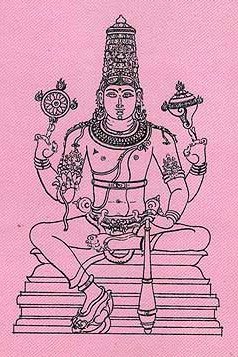Shadakshara, Ṣaḍakṣara: 7 definitions
Introduction:
Shadakshara means something in Hinduism, Sanskrit, Marathi. If you want to know the exact meaning, history, etymology or English translation of this term then check out the descriptions on this page. Add your comment or reference to a book if you want to contribute to this summary article.
The Sanskrit term Ṣaḍakṣara can be transliterated into English as Sadaksara or Shadakshara, using the IAST transliteration scheme (?).
In Hinduism
Pancaratra (worship of Nārāyaṇa)
Source: archive.org: Catalogue of Pancaratra Agama TextsṢaḍakṣara (षडक्षर) refers to the “six-syllable mantra”, as described in the seventh chapter of the Agastyasaṃhitā (agastya-suīkṣṇa-saṃvāda edition), an ancient Pāñcarātra Āgama text dealing with the worship of Rāma, Sītā, Lakṣmaṇa and Hanumān.—Description of the chapter [ṣaḍakṣara-māhātmya]: [...] Śiva requests that Rāma grant to Śiva’s devotees their long-sought emancipation; and, even as he is asking, his followers become one with Viṣṇu [sarve jyotirmayāssantaḥ viṣṇāveva layam gatāḥ]. Rāma offered Śiva another boon, and Śiva asks that all who die on the banks of the Ganges, whether naturally or unnaturally, be given the gift of mukti. Rāma agrees, even extending the condition to the smallest insects. Rāma adds that any who hear the six-syllable mantra, either from the lips of Brahmā or now from Śiva, will attain the highest. Also, whoever worships Him (Rāma) in an idol form using the six-syllable mantra, will achieve liberation.

Pancaratra (पाञ्चरात्र, pāñcarātra) represents a tradition of Hinduism where Narayana is revered and worshipped. Closeley related to Vaishnavism, the Pancaratra literature includes various Agamas and tantras incorporating many Vaishnava philosophies.
Languages of India and abroad
Marathi-English dictionary
Source: DDSA: The Molesworth Marathi and English Dictionaryṣaḍakṣara (षडक्षर).—n (ṣaṣ & akṣara) Six letters, viz. kāṃ, hīṃ, yē, ta, nā, hīṃ, forming kāṃhīṃ yēta nāhīṃ He &c. knows nothing--is quite an ignoramus. A humorous expression for Learning or letters in affirming or allowing it of a person utterly ignorant. Ex. hōya tō vidvān tara tyāsa ṣa0 yētēṃ--valde homo literarum scilicet sex literarum. ṣaḍakṣarīmantra (The spell or mystic formula of six letters.) Absolute illiterateness or profound lack of scholarship.
Marathi is an Indo-European language having over 70 million native speakers people in (predominantly) Maharashtra India. Marathi, like many other Indo-Aryan languages, evolved from early forms of Prakrit, which itself is a subset of Sanskrit, one of the most ancient languages of the world.
Sanskrit dictionary
Source: Cologne Digital Sanskrit Dictionaries: Benfey Sanskrit-English DictionaryṢaḍakṣara (षडक्षर).—adj. containing six syllables, [Pañcatantra] i. [distich] 184.
Ṣaḍakṣara is a Sanskrit compound consisting of the terms ṣaṣ and akṣara (अक्षर).
Source: Cologne Digital Sanskrit Dictionaries: Cappeller Sanskrit-English DictionaryṢaḍakṣara (षडक्षर).—[feminine] ī containing six syllables.
Source: Cologne Digital Sanskrit Dictionaries: Monier-Williams Sanskrit-English DictionaryṢaḍakṣara (षडक्षर):—[=ṣaḍ-akṣara] [from ṣaḍ > ṣaṣ] mf(ī)n. (ṣaḍor ṣaL-) consisting of six syllables (rīmahā-vidyā, [Pañcarātra; Kāraṇḍa-vyūha]), [Vājasaneyi-saṃhitā; Śāṅkhāyana-gṛhya-sūtra] etc.
[Sanskrit to German]
Sanskrit, also spelled संस्कृतम् (saṃskṛtam), is an ancient language of India commonly seen as the grandmother of the Indo-European language family (even English!). Closely allied with Prakrit and Pali, Sanskrit is more exhaustive in both grammar and terms and has the most extensive collection of literature in the world, greatly surpassing its sister-languages Greek and Latin.
Kannada-English dictionary
Source: Alar: Kannada-English corpusṢaḍakṣara (ಷಡಕ್ಷರ):—
1) [noun] any set of six syllables.
2) [noun] Śiva.
Kannada is a Dravidian language (as opposed to the Indo-European language family) mainly spoken in the southwestern region of India.
See also (Relevant definitions)
Partial matches: Shash, Akshara, Sat.
Starts with: Shadaksharamahatmya, Shadaksharamantra, Shadaksharamaya, Shadaksharastotra, Shataksharam.
Ends with: Ashtacatvarimshadakshara, Catushcatvarimshadakshara, Catustrimshadakshara, Catvarimshadakshara, Dvapancashadakshara, Dvatrimshadakshara, Ekatrimshadakshara, Shattrimshadakshara, Sudarshanashadakshara, Trayastrimshadakshara, Trimshadakshara.
Full-text: Shadaksharastotra, Shadaksharamaya, Shivashadaksharastotra, Ramashadaksharavidhana, Ramashadaksharamantraraja, Sudarshanashadakshara, Shadaksharideva, Catakkaram, Shataksharam, Tryakshara, Vyapakamantra, Shal, Shriramanavamiprashamsa.
Relevant text
Search found 5 books and stories containing Shadakshara, Ṣaḍakṣara, Sadaksara, Shash-akshara, Ṣaṣ-akṣara, Sas-aksara, Shad-akshara, Ṣaḍ-akṣara, Sad-aksara; (plurals include: Shadaksharas, Ṣaḍakṣaras, Sadaksaras, aksharas, akṣaras, aksaras). You can also click to the full overview containing English textual excerpts. Below are direct links for the most relevant articles:
The Linga Purana (by J. L. Shastri)
Chapter 8 - The eight-syllabled Mantra < [Section 2 - Pūrvabhāga]
Garga Samhita (English) (by Danavir Goswami)
Verse 8.13.127 < [Chapter 13 - A Thousand Names of Lord Balarāma]
Chaitanya Bhagavata (by Bhumipati Dāsa)
Verse 1.5.18 < [Chapter 5 - Eating the Mendicant Brāhmaṇa’s Offerings]
A Dictionary Of Chinese Buddhist Terms (by William Edward Soothill)